Over the last two decades, social media usage has increased dramatically. The ability to access the internet on the move and stream content has made social media more accessible. It shouldn’t surprise you — or anyone — that people spend more than 2 hours, on average, on social media each day.
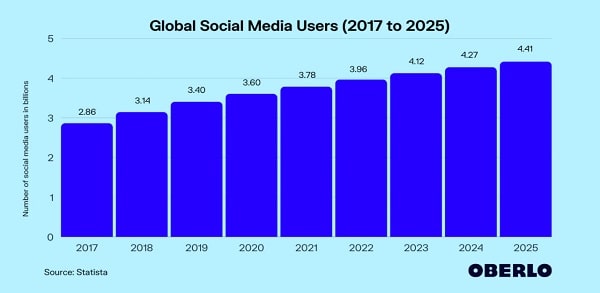
Source: Oberlo
The time people spend on social media provides a significant opportunity for businesses to grow their customer base. You can engage with prospects directly or reconnect with people who engaged with you on other platforms through social media. The latter is the focus of this article.
Social media remarketing should be your marketing strategy. But it shouldn’t be the only one. You can write a quality guest post to get other people to notice you, too. The point is, you should complement social media retargeting with other marketing strategies for the best results.
Having said that, this blog post will explain six ways to leverage audience retargeting on social media to help your business gain more visibility and boost your profit margins.
1. Target segments of your audience
When running a social media campaign, it’s imperative you market products to an audience whose interests align with your offering. It’s a no-brainer, but imagine trying to sell running shoes to someone with no interest in sports, athleisure, or fitness?
It would be a colossal waste of time, effort, and resources. Rather, you should be targeting people based on their interests.
Facebook currently provides you with six options to define the relationship between your business and your audience. You can run retargeting ads based on CSV data, website traffic, app activity, offline activity, and engagement.
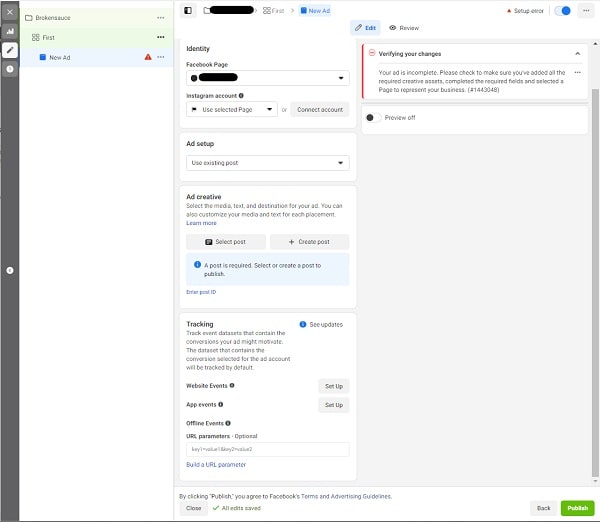
You should take advantage of these different retargeting options to run relevant ads to your audience based on their recent engagements with your company. For example, if you recently ran a sales campaign to your email list, it would be logical to retarget those visitors with ads about your promotion.
Running different retargeting campaigns based on how people interact with your company will take time. Higher conversion rates and improved ad relevancy make this extra effort worth it.
2. Keep Your Ads Simple and in Line With the Brand Voice
On social media, you’re competing for the attention of your audience. Don’t slip up by letting a potential customer bounce off your ads because of muddled messaging. Instead, create simple, clear ads that reflect your brand style and voice.
When retargeting an audience, you must be consistent with your brand’s color scheme, voice, and personality. That means your ads should have similarities with your email marketing material and with your website, too. That way, your audience becomes familiar with your brand.
Just as importantly, you need to have a clear message to build your audience. You need to distill the essence of your message so it’s immediately clear what you want to accomplish. That’s critical, given that people encounter retargeting ads while doing other things.
Here’s a superb example of Slack delivering a simple Facebook ad.

Source: Wordstream
Slack’s ad is simple, visually appealing, and lighthearted. Their color scheme and brand voice are consistent and reflect their business’ core focus by telling users how they’ll feel after using the platform. The messaging is clear as well; reduce team meetings by using Slack.
As with Slack’s example, ensure to use a simple, memorable, and catchy CTA. Taking these steps will improve the chances of conversion.
3. Don’t Assume People Want to Buy
The easiest type of retargeting campaign to run is around the checkout. You target people who visited your sales page and send a targeted message where you try to get them to complete a purchase. Many companies struggle to scale retargeting ads past the sales page because the ads fail to show a Return On Investment.
The fundamental problem here is rather straightforward. Most people aren’t ready to make a purchase when they visit a website.
Rather than running retargeting ads to generate a sale directly, consider how you can connect and nurture the lead. Once you have built that trust with a person, you are much more likely to make a sale.
One company that takes this approach is King Kong Agency, based in Australia. Rather than directly trying to generate a sale, King Kong focuses on getting leads onto an email list. Here’s an example of one of the company’s retargeting ads.
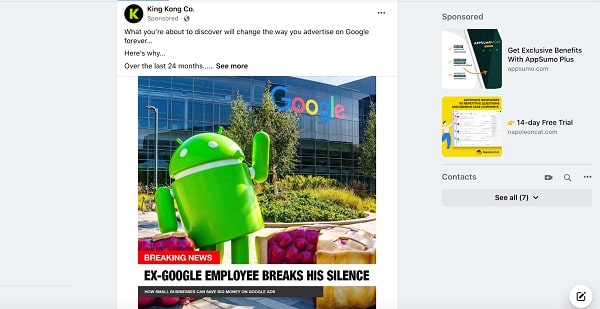
The ad relies on curiosity to get clicks. You can see the news-style graphics on the image. The ad has collected a lot of social engagement, which will improve the Click Through Rate (CTR).
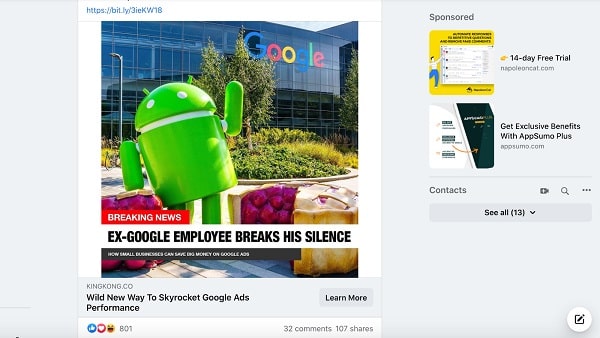
People who click on the ad are directed to a landing page where they can download an eBook.
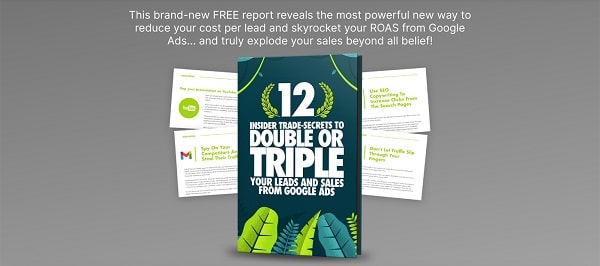
Once on the company’s list, prospects receive a range of sales and marketing material to educate the audience and build trust with the company. That approach increases the number of leads who enter the marketing funnel and, subsequently, the number of customers.
To run these types of retargeting campaigns, you can use newsletter templates to save time. You also need to define the value of an email subscriber for your company. Once you know this figure, you can run retargeting campaigns because you understand your Return On Ad Spend (ROAS).
4. Use Multivariate testing
There are three principle levers that you can play with when running ads. You have the ad copy and visuals, the landing page experience, and your targeting. You need to tweak and optimize each of these three levers to maximize your conversions.
Multivariate and A/B tests will improve your conversion rate and reduce your Cost Per Acquisition (CPA). Through multivariate testing, you can continuously test your ads to see which variation performs best when it goes live.

Create several versions of your ad copy and images for use in your marketing campaign. The higher the marketing budget, the more content you should create.
Alongside testing the creative, you should also experiment with ad placement and the type of media. For example, testing video vs. images to see which version generates the most engagement.
5. Set a Limit on Ads
Showing the same ad repeatedly to your audience can overwhelm and annoy them. Do it more often, and you defeat the purpose of the retargeting campaign.
Putting a limit on your ads increases your chances of greater visibility while keeping your brand’s image intact. Control the frequency of your remarketed ads. You don’t want people to get overwhelmed or overexposed to your brand.

You also need to monitor ad results over time. In most instances, ad effectiveness decreases because your audience has already seen the ads or your competitors imitate your approach. In both instances, this can result in “ad blindness.”
6. Use Burn Pixels
If you’ve ever bought a product online (via an ad) but somehow still keep seeing the same ad when you come online, how would you feel? Irritated, no?
Great. Now, don’t make the same mistakes with your audience.
When a person you are targeting converts, don’t keep showing them your ads for the same product — it’s spammy and annoying. Aim for visibility, not overexposure. While converted users may be useful for other retargeting campaigns, don’t let them make one transaction twice.
Burn pixels are tracking tools that stop this from happening. It prevents converted users from seeing your ads. These tracking pixels are placed on your transaction page to identify already converted consumers and untag them, making sure you don’t keep serving them ads. Along with these, burn pixels help you save more and allow you to focus on other targets who might want your product.
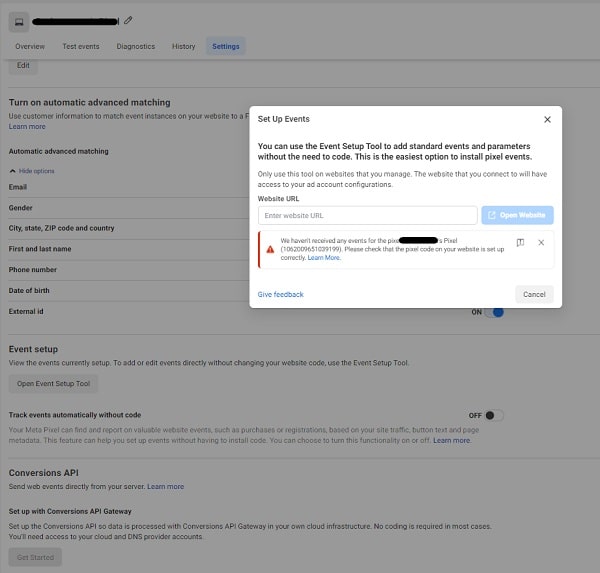
On Facebook, you can easily set up burn pixels using Events Manager. This allows you to determine the types of incidents that will trigger ad retargeting while setting limits on specific events.
Related Content
- 5 Great Retargeting (Remarketing) Examples and Ideas for Inspiration
- Top 5 Retargeting (Remarketing) Ad Best Practices
- 3 Ways to Use Retargeting to Find Success Online
Conclusion
Social media retargeting is not a one-shot deal.
When creating remarketing campaigns, ensure you create a custom audience and personalize your ads to align with their interests and business offerings. As retargeting your audience is a gradual effort, you need to tweak and optimize your remarketing ads for success continuously.
You can retarget your social media audience by creating and targeting specific segments based on their online behavior and preferences, keeping ads simple, not assuming that everyone wants to make a purchase right away, testing different versions of your ads and seeing which ones are most effective, setting limits on your ads, and using burn pixels to reduce redundant ads.
When done correctly, social retargeting is an effective strategy for gaining social media visibility and reaching out to users with the potential to convert.
___

Written by our guest writer Daryl Bush, the Business Development Manager at Authority.Builders.
The company helps businesses acquire more customers through improved online search rankings. He has extensive knowledge of SEO and business development.

